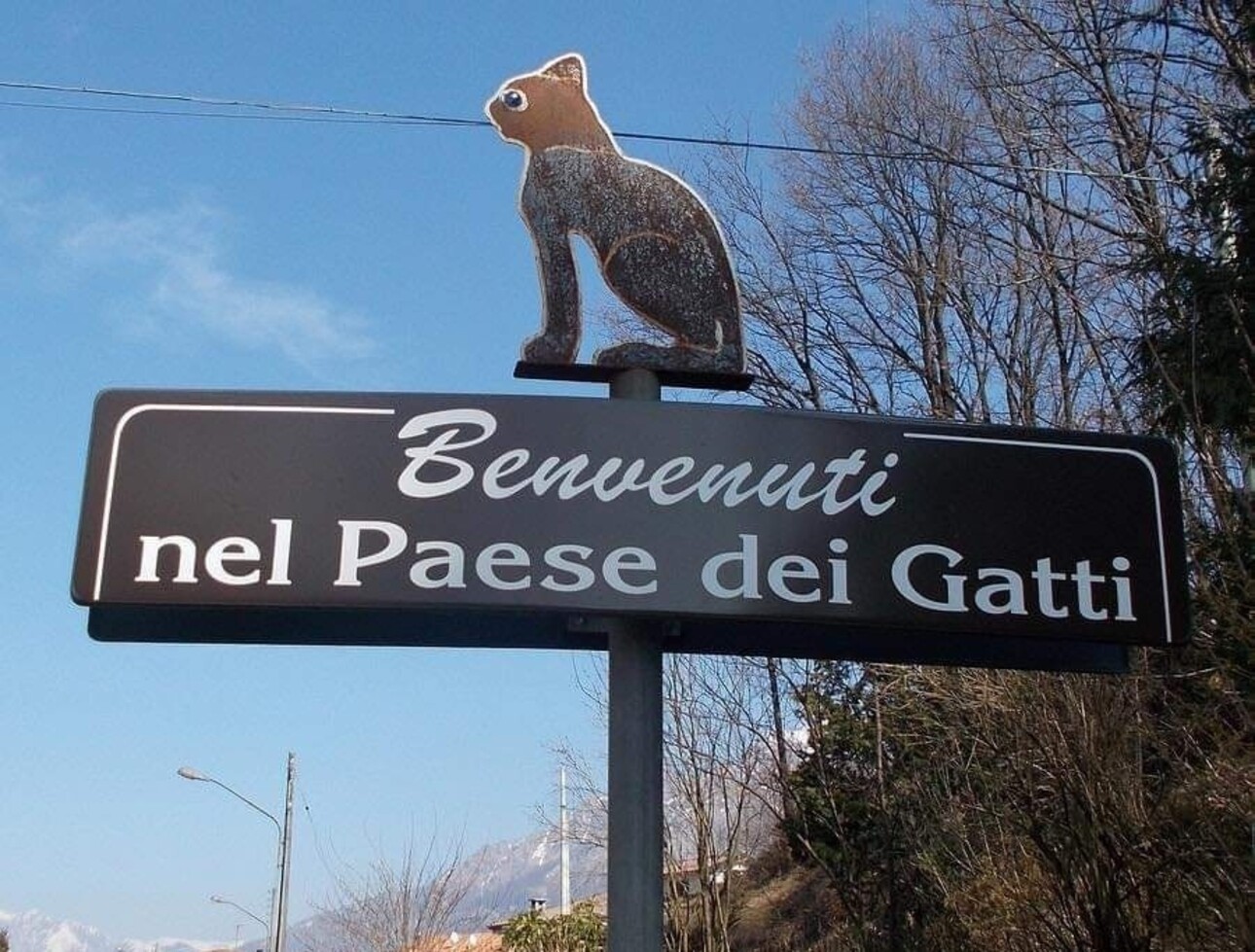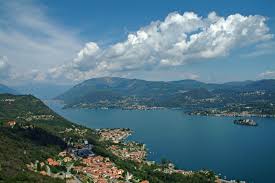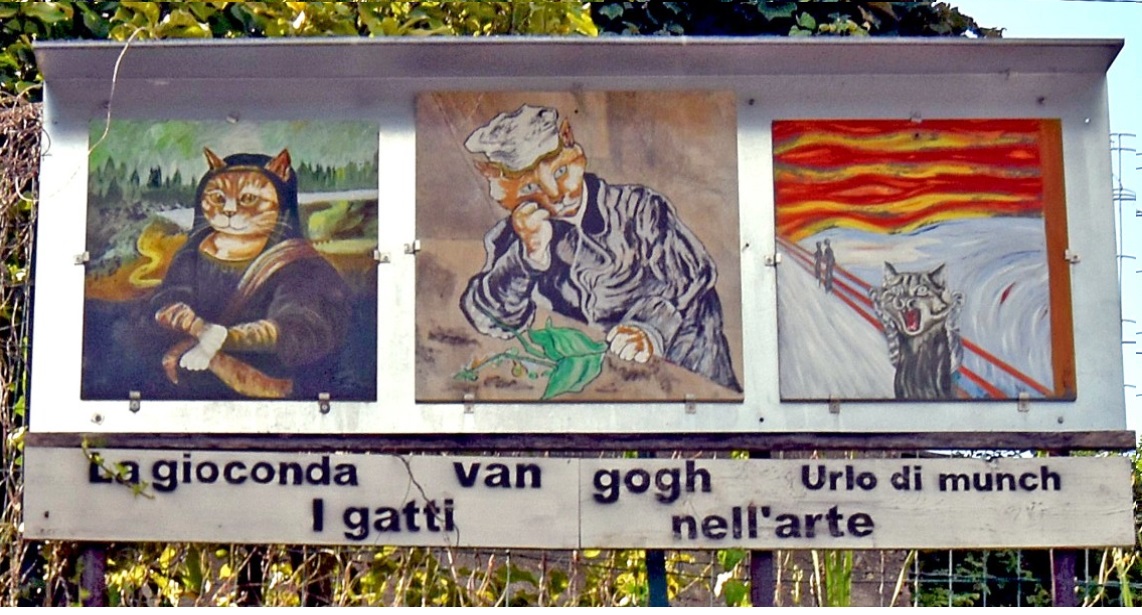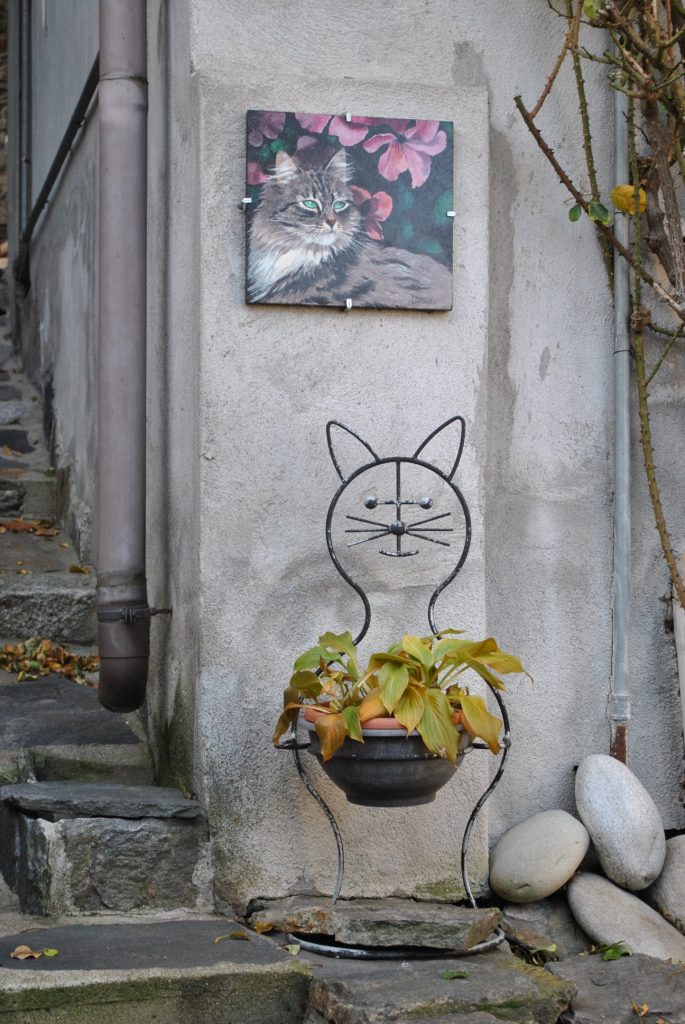The legend of Saint Julius  Only a dragon survived and took refuge in a cave in the Orta peninsula, from which it no longer came out. Legend has it that in this
cave was found a dragon bone and still today hung above the table in the sacristy of the Basilica of San Giulio (this is not a legend,
a bone is really in the sacristy!). BROLO - The town of cats  In short, everything here is inspired by these noble and enigmatic creatures. The place, ideal for cat lovers from all over the world,
is visited above all by families with children who, curious and fascinated, stop to watch and caress the beloved felines. But why is Brolo
the town of cats? A curious legend explains it to us.
  RATAFIA Ratafia is a sweet alcoholic drink from Biella, a city in the northern Italian region of Piedmont.
Its name comes from the Latin phrase 'rata fiat', which means 'the deal has been made'. The history revolves around ratifying legal or political
matters, where both parties would share a drink after signing documents.  THE LEGEND OF "LAGO DELLA VECCHIA" IN VALLE CERVO Valle Cervo, in the province of Biella, offers a multitude of itineraries suitable
for even the most experienced walkers. One of the most beautiful trails is an ancient mule track that leads from the pretty
village of Piedicavallo to the very picturesque Lago della Vecchia (the Old Woman's Lake).  She died many years later, but even today, when the moon is full, there are those who claim that a ghost with a graceful figure and long white hair wanders on the surface of the lake. HOW LAKE MERGOZZO WAS BORN Lake Mergozzo, one of the cleanest and picturesque lake in Europe, is a very tiny basin in the province
of Verbania, but in the ancient times constituted the most Western part of Lake Maggiore. The continuous floods of river Toce
contributed to the emersion of a stretch of land, which divided Lake Major into two basins. Lake Mergozzo was born. The lake is
still connected to Lake Major thanks to a channel long 2.7 km.  To protect this corner of peace is the town of Mergozzo, a small village characterised by typical stone houses that almost seem to hug each other as they are so close, only divided by small streets that give life to some of the most amazing views. GORGONZOLA CHEESE Gorgonzola is one of the most important Italian cheeses.
Its origin goes back a thousand years to the town of Gorgonzola in today's province of Milano, but look a bit further and the path might actually lead to
Piemonte. Legend states that in the 12th century a herdsman was travelling to summer pastures in Valsassina when he left a version of gorgonzola in the town. The cheese was appropriated by the local population and the rest, as they say, is history. In the year 2020, more than 5 million wheels reached various countries around the world for an estimated turnover of 800 million euros. gorgonzola appeared on the first class menu of the Titanic, confirming how much the English appreciated it.  THE LEGEND OF BASILISK The imagination of inhabitants of Alpine areas has generated various mythical animals. The
difficult access to wild areas, the isolation of populations and the fear of a largely unknown
nature has thus given rise to many fantasy creatures that are added to devils, masks, gnomes,
etc. Among these animals, one of the most mysterious is the basilisk.
Little known outside the Alpine areas, it has experienced an increase in fame and popularity
after being included in the Harry Potter saga.
From time immemorial, throughout Europe but especially in the mountainous regions, there
has been a story of a reptile with hypnotic properties, extremely dangerous. In the Alps, the
area where the legend of the basilisk has been most widespread is undoubtedly the Val
Vigezzo, North Piedmont, Italy. The myth of the basilisk in this valley is so strong and
widespread that the Municipality of Malesco wanted to make it its symbol and a few years
ago even dedicated a fountain monument in its main square. The fountain has the shape of a
quite common wildflower called Tormentilla, Potentilla or Tormentilla erecta, a 4-petaled
yellow rosacea, quite common in Malesco pastures. This plant has been known for its
healing properties since time immemorial. At the center of the fountain there is a huge
boulder of "soapstone", Steatite, an opaque green rock composed of Calcium, Magnesite
and a small part of Chlorite. The Basilisk is positioned above the green boulder.
The myth of the basilisk has very ancient origins: the first to leave us a written record was
Pliny the Elder in his "Naturalis Historia". According to Pliny, the basilisk would be a small
snake, less than twenty centimeters long, with a spot like a crown on its head. Unlike
snakes, it does not crawl, but advances with its body half erected. Despite its size it is the
deadliest creature ever; it is very poisonous, capable of killing with just a look or breath. His
breath withers fruit, his spit burns and corrodes, his gaze splits stones. The basilisk lives in
the desert he created himself, because it can dry the shrubs as well as with contact, with just
the look. A knight who struck the basilisk was killed along with the horse by the poison that
infiltrated through the spear!
According to Pliny, the only way to kill the basilisk is to throw a weasel into its den, the
smell of her kills it, but she too dies. According to a medieval belief, he can only be
defeated with a mirror: his own gaze reflected in the mirror would kill him. Some images
and descriptions of medieval origin represent the basilisk as a cross between a rooster and a
snake.  The Ossola Valley  THE RICE FIELDS  |
|
|

|
|
 Brolo, hamlet of Nonio, in Piemonte, is known as the land of cats. Along its streets you can meet numerous free cats, which are looked after
and cared for by the locals. Furthermore, several paintings depicting the beloved felines appear on the roofs and walls of the houses.
 Brolo is a small village of only 357 inhabitants overlooking the lake Orta. The reason why it is known as the town of cats is linked
to an old story, which began on 10 October 1756. That day, during a session of the community council, the city of Brolo asked the town
of Nonio to separate at the level ecclesiastic from the Parish of San Biagio because to reach it, the inhabitants were forced to cross
a river subject to floods. Brolo stated that he would independently furnish and manage the church of Sant'Antonio Abate.
Faced with the skepticism of the inhabitants of Nonio, they began to say: "When there is a parish in Brolo, the mouse will put on its cloak". The citizens of Brolo took the matter seriously and, like cats, chased away all the mice, that is, the inhabitants of Nonio, from the town. It was April 27, 1767 and outside the church they hung a mouse with a cloak. Their new motto became: "The parish was created in Brolo and the rat put on his cloak". The new parish was that of Sant'Antonio Abate. From that moment on, the citizens of Brolo used the cat as a symbol to give an identity to their village.  The writer Angelo Brofferio, in The Italian Traditions (1848), reports the legend of a cherry liqueur which, in the year 1000,
saved the population of Andorno from the plague, making it possible to marry the daughter of the inventor of this liqueur and the son
of the his fiercest enemy. Peace between the two families was thus re-established, and the phrase that was pronounced to seal the union
between the two young people "et sic res rata fiat" gave the name to this magical liqueur. In 1700 the apothecary Pietro Rappis began the
artisan production; in 1880 Giovanni Rapa, founder of the liqueur factory of the same name, picked up the tradition that still continues
respecting the ancient recipes. Prepared with the juice of fine black cherries, sugar and aromas, it is particularly appreciated for its
sweet flavor. A slight alcohol content makes it a liqueur that everyone likes. It is recommended to drink it cold, with ice or straight.
Excellent ingredient in the preparation of the most delicious desserts, with fruit salad and ice cream. Ingredients: sugar, alcohol, cherry
juice, natural flavors, natural color. Alcoholic content: 26%.  An old legend tells that, many years ago, a young stranger fell in love with a beautiful local girl. On a rock, not far from the lake,
an altar was set up to celebrate their wedding, but the bride waited there all day and all night for her fiancé, but he never arrived.
The next morning a man brought the maiden the sad news that her betrothed had been killed in the forest. The young man was buried at the
bottom of the lake and the girl spent the rest of her life there until she grew old, living with a bear she had befriended, to watch over
her beloved.   One of the main characteristics of Lake is that its waters are one of the clearest in Italy thanks to the lack of industrial manufacturers
on its shores, the ban on the use of motorboats, and a drainage system not discharging in the basin.   Winston Churchill was also a fan and it was probably inside the restaurant of the House of Commons where he fell in love with the
Italian blue cheese. Indeed, on weekends in the 1940s, a goods train loaded with cheeses left Novara for London.
It is even said that during the Second World War as Prime Minister he marked the area of Gorgonzola with a red circle to prevent the bombers
from destroying the dairies where his favourite cheese was produced!
  Even today in the Ossola valleys it is easy to find someone who swears to have met or at
least glimpsed this mythical animal. The popular names given to the basilisk are various:
"Sarpent de la cestra", "Sarpent dai ugiài", "Sarpent Gatt", etc. A parish priest of
Domodossola, passionate hiker and expert of the surrounding mountains, tells of having
seen an animal difficult to identify one day in the thick vegetation. He describes it as being
about 60cm long, with the shape of a bottle and the ability to roll quickly off the slopes.
Amazed by the particularity of the sighting, he considered it appropriate to notify a
veterinarian from Domodossola, a long-time student of the local reptiles. The doctor, during
his studies in the specific field, confirms the existence of this legend for some time. He has
collected and continues to receive strange reports which, according to him, are for the most
part the result of tourists and local inhabitants' suggestion. A possible explanation can be
based on the ancient geological nature of these valleys: as is well known, the Ossola
mountains are rich in fossil finds dating back to the prehistoric era; it is not difficult,
therefore, to find rocks containing fossil fish and shells. Hence the hypothesis does not
exclude the possibility that some prehistoric reptile could have survived, although evolving
over the centuries into an animal that has never been classified and is in danger of extinction
(if not recently extinct). This authoritative hypothesis contributes to making this interesting
and curious legend even more alive, destined to last over time. The fountain with the
basilisk monument, made by the Milanese artist Luca Di Francesco, is clearly inspired by
this real animal rather than by myth. If you ever happen to visit Malesco go visit this
fountain, but please don't look the Basilisk in the eye!
|
More than 50% of Italy's rice production is in Piemonte. 
|
|
|